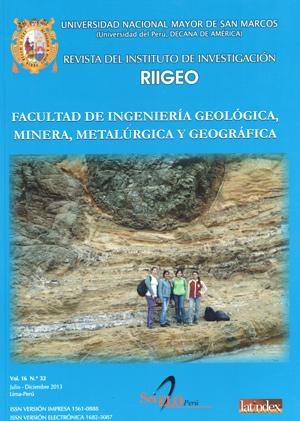Quality of biogas obtained from biological and organic household waste pre-treated with the technique of bocashi
DOI:
https://doi.org/10.15381/iigeo.v16i32.11322Keywords:
Bio digestor, bio fertilizer, bio gas, bokashi, beneficial microorganismAbstract
Increasing generation of organic and agriculture residues as a product of both human activities and poor final disposal of these residues, leads us to think on new techniques to improve environmental quality and population income. Organic residues have a potential economic value as a row material for bio digesters minimizing at the time environmental pollution. This study tests the feasibility of bio fertilizer and bio gas production in bio digesters using cattle manure and organic residues from the dining room of La Molina Agrarian University. Bokashi pretreatment method used for this test, consists of applying beneficial microorganisms for degrading organic waste. Three treatments 1, 2 and 3, were tried using organic residues from dining hall, cattle manure and a mixture of organic waste from dining hall and cattle manure respectively.
The average quality of bio gas attained arranged from higher to lower was as follows: Treatment 3, 58.6 % CH4, 32.6 % CO2.
Treatment 2, 55 % CH4, 32 % CO2 and Treatment 3, 26.2 % CH4, 30.1 % CO2. On the other hand bio gas production in order of importance was: Treatment 2, 0.23 m3/kg ST, Treatment 3, 0.20 m3/kg ST and Treatment 1 0.009 m3/kg ST. Bio fertilizer analysis shows high levels of nutrients and thus it can be used for soil improvement in agriculture. Fecal and total coliform levels by microbiological analysis, were below Peruvian normal levels for irrigation water. We conclude that bokashi pretreatment method of organic residues allows acceptable production levels and quality of bio gas and boil.
Downloads
Published
Issue
Section
License
Copyright (c) 2013 José Cárdenas C., Lawrence Quipuzco U., Víctor Meza C.

This work is licensed under a Creative Commons Attribution-NonCommercial-ShareAlike 4.0 International License.
AUTHORS RETAIN THEIR RIGHTS:
a. Authors retain their trade mark rights and patent, and also on any process or procedure described in the article.
b. Authors retain their right to share, copy, distribute, perform and publicly communicate their article (eg, to place their article in an institutional repository or publish it in a book), with an acknowledgment of its initial publication in the Rev. Inst. investig. Fac. minas metal cienc. geogr.
c. Authors retain theirs right to make a subsequent publication of their work, to use the article or any part thereof (eg a compilation of his papers, lecture notes, thesis, or a book), always indicating the source of publication (the originator of the work, journal, volume, number and date).






